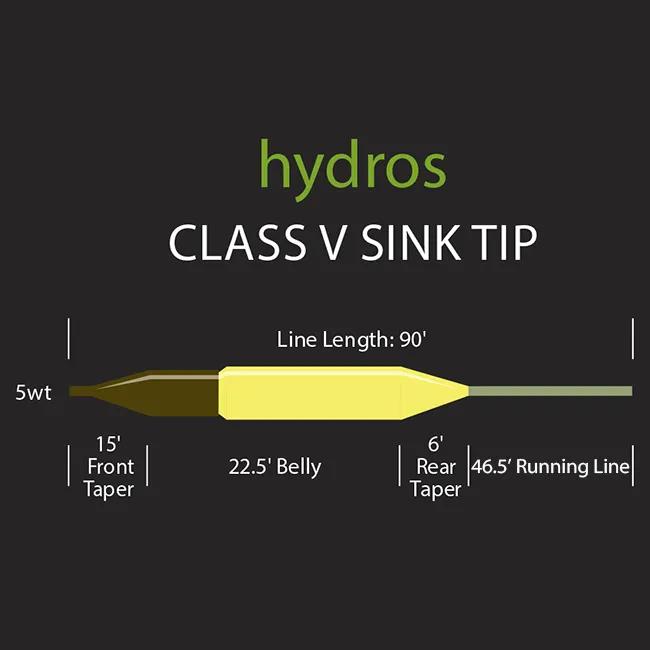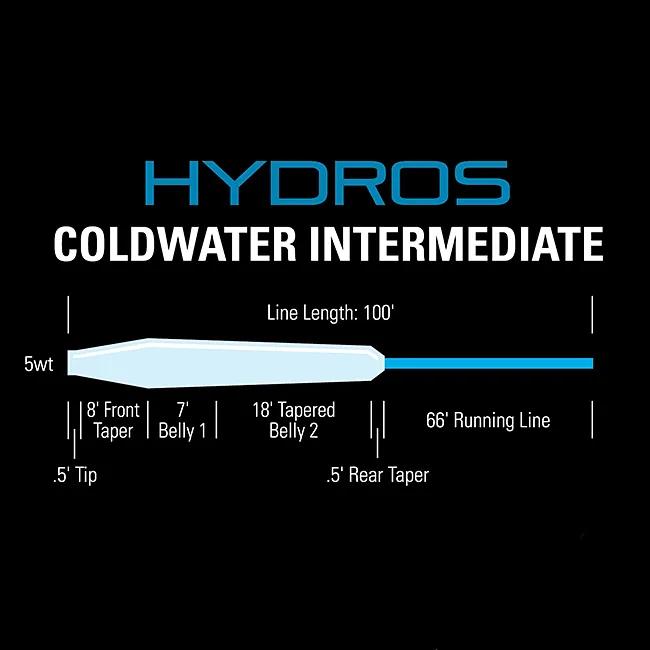
Fishing with Sinking lines and Sinking tips
Fly fishing industry insiders like to reference the movie A River Runs Through It as a bench mark in the growth of the sport from a cult like following into a mainstream recreational activity. The classic novel by Norman Maclean was made into a Hollywood block buster, staring Brad Pitt, and the movie brought the sport of fly fishing to the attention of millions of people. You’ll often hear industry types talking about the sport before and after the “Movie”. If you’ve seen the move, you know Hollywood did a wonderful job of capturing the romance of fly fishing. The art of casting a fly rod in a magical setting, sharing the moment with your friends and family is what attracted many of us to the sport. In the movie, Brad Pitt’s character demonstrates ‘shadow casting’, a technique only Hollywood would expect to produce the giant brown trout it does in the climatic fishing scene. While I’ve never heard of this technique producing a fish in real life, there are plenty of effective ways to catch a trophy trout.
The truth is, some of the most effective fly fishing techniques share little in common with ‘Shadow casting’. For those looking to land a truly large Montana brown trout, throwing streamers is the best game in town. While streamers can often be thrown on floating lines, sometimes you need to get down to the fish. One over looked technique is the use of full sinking vs sink tip fly lines for effective streamer fishing. Choosing the right sinking line can be critical to a successful day of "hucking junk". Fishing with sink tips can be more difficult than a standard dry fly rig or nymph fishing set up, but there are a few tricks to making fishing with a sink tip or full sinking line more enjoyable.
Sink Tip V. Full Sinking
Let’s discuss the difference between a full sinking line and a sink tip line. Fly line manufactures produce a variety of fly lines; floating, full sinking, sink tips, multiple tapers… the list goes on. For the purpose of this article, let’s focus on full sinking and sink tips lines. A full sinking line, is as described; the entire length of the fly line sinks at a specified rate. Correspondingly, on a sink tip line, only the tip section sinks at the specified rate. The sinking section of the line can range from a few feet up to 30 feet.

Sink rates for both lines range from a half inch per second to several inches per second. The higher the sink rate the faster the tip (or line) sinks. Thus, the deeper the water needs to be, for effective fishing. Knowing the sink rate for each line will allow you to ‘count down’ to the depth you want to present the fly which is a common practice for stillwaters or slow moving rivers. For example, a type 3 sink tip typically sinks at a rate of 3 inches per second. So, it you count to 5, the tip and your fly will be about 15 inches below the surface of the water.

Sink tips are very common when fishing streamers in rivers while full sinking lines are more commonly use while fishing in stillwaters (lakes and/or ponds). When selecting the right line, it is critical to consider the waters you want to fish. In a river, if you fish too heavy of a line you will reach the bottom of the river quickly, increasing the chances of snagging flies on the bottom and losing flies and valuable fishing time. A medium sink rate will perform better, 2-5 inches per second is a great place to start for most river fishing situations. The length of a sink tip varies from just a few feet to longer 20-30 foot sinking tips. In Montana we use shorter sink tips when fish are on the banks such as on the Yellowstone River just after run off. Short sink tips allow you to recast without stripping the majority of the line back to the boat. When fish are in the middle of large runs, like in October, longer 20-30 foot sink tips are preferred. Long sink tips require that most of the line be retrieved before recasting, but they are much more effective at getting your flies down fast. In Montana we most commonly use a 150-200 grain long sinking head (sink rates 5-7" per second) when fishing larger rivers when fish are holding deep in mid river runs. The long sinking heads are preferred over full sink lines because the running lines float and are easier to manage for repetitive casting.

Full sinking lines are crucial for effectively fishing a lake. They keep the fly ‘fishing’ in the feeding zone for a longer distance than a sink tip lines or full floating line. Since casting and retrieving the fly is the most common technique in stillwater situations, it is important to understand the difference in how the types of fly lines will present the fly to hungry fish. When fishing a floating line, or sink tip line, the fly will sink to the desired depth (the countdown equation) before starting the retrieve. Once the retrieve begins, the fly line will pull the fly in the same direction it is being retrieved. In the case of a floating line, that is towards the surface. In this case, the fly will travel vertically in the water column, only spending a few moments in the feeding zone. A sink tip line will hover in the feeding zone for a longer distance as it is stripped back to be recast. But, a full sinking line will stay at the depth for nearly the entire length of the retrieve. A full sinking intermediate line is the most common fly line for fishing lakes and ponds. The entire line will sink at a rate of 1/2 inch to 1 ½ half inches per second. Since the entire length of the line sinks, it will retrieve (fish) the same way. Once you have started the retrieve the line and flies will stop sinking and will ‘hover’ in that column of water, giving your fly more time in the prime feeding zone.

Rigging Sinking Lines
Another aspect to consider when fishing sink tips and full sinking lines is the leader length. The most common way to rig a sinking tip line for river fishing is with a short, stout leader. The same is often true in most still water presentations. A short stout leader will allow the fly to sink at nearly the same rate as the sink tip or line. If the leader is too long, or if it is not stout enough, the sink tip will sink faster than the fly creating a vertical bow in the line. The fly won’t sink as much as wanted and the line tends to snag on the river bottom. Of course, this could can be used to your advantage too. Incorporating a long leader with a sink tip will create a fly that appears to swim deep before it swims to the surface. This could be just what’s needed to entice a strike from a hungry brown trout cruising the banks of a lake.
Ways to Use Sinking Lines
Sink tips and full sinking lines are used for other species, not just while trout fishing. When fishing for largemouth bass, a buoyant fly like a foam diver or popper attached to a sink tip will produce life like action of a diving frog. When the fly lands on the surface it floats while the sink tip line begins to sink. Pausing for few counts before starting to strip the fly, will allow the tip to sink forcing the fly (no matter how buoyant) to ‘swim’ under the surface just like a real frog would. This is just one way of using a sink tip to produce a unique and effective fishing technique.
Another productive way to use a sink tip line is while streamer fishing. The basic way to utilize a sink tip and streamer set up is the cast the fly close to bank, count to 3-5, then perform a series of strips to add action to the fly. When fish are mid river you can cast across current and give the line time to sink and then begin your retrieve when the link swings to 45 degrees downstream. This can be done while wade fishing or also from a boat that is slowed by back rowing. An important note: while fishing streamers in rivers, you will find best way to rig the line, leader, and fly is with a short stout leader. We prefer short 3-4 foot sections of heavy 0-2X flouro carbon. There is no need for a long leader and heavier tippet helps you hang on to big browns over 20". If the river is full of timber, snags, or undercut banks, shortening the shorter leader will also allow for more accurate casting without losing the ability to fool a hungry streamer eating fish. A more sophisticated technique, that will help increase productivity goes like this: Cast the fly as close to structure without snagging as you can. Once the fly lands on the water, roll cast more slack into the line. Rolling casting and mending slack into the line downstream of the fly, before retrieving back to the boat will cause the fly to ‘swim’ with the current along the bank. Remember a streamer imitates baitfish like sculpin, juvenile salmonids, or crayfish, all small critters that swim with the current, especially when evading predators. Creating slack in the line downstream of the fly before stripping will produce more strikes and bring more fish to the boat.
Casting
Sink tip and full sinking lines are not the easiest to cast, especially the ones with the fastest sink rates. The most challenging portion of the cast is at the beginning. Since the end of the line farthest from you has sunk below the surface of water, you must get the line and fly out of the water. This can be difficult for less experienced fly casters. A helpful trick is to strip the line and fly in more than normal. The shorter line will free itself from the water much easier as start the back cast. Once airborne, the casting stroke should be adjusted slightly too. For easier casting open the range of motion of the cast. This will open the casting loop keeping the tip, leader, and fly from tangling. Most sink tip lines will cast the same as shooting heads. The fewer back casts the better the cast will be. If possible, make one back cast, then shoot the line towards the target. Once you get the hang of casting a long bellied heavy sink tip you will realize you can shoot line much farther than you can with a floating line. Casting a 200 grain sink tip is actually more efficient for covering water with streamers than a floating line as a result.
No one has ever said that casting sink tips or sinking lines is beautiful, and there is no way it can compare to the alluring scene of Shadow Casting in the movies A River Runs Through It. But then, fishing with a sink tip will out fish the best Shadow Caster, even in the movies. For more information about fly fishing with a sink tip or a full sinking line, please feel free to reach out to us here at Montana Angler Fly Fishing.
